Among the most ancient objects in the universe, these metal-poor, giant balls of stars are still not fully understood. Are all the stars in a Globular Cluster (GC) formed in one generation, or multiple generations over several hundred million years? Observations suggest that they are created in regions of efficient star formation, where the density of the interstellar medium is higher than normal star-forming regions. There also seems to be a correlation between the mass of the Super Massive Black Hole at the centre of host elliptical or lenticular galaxies and the combined mass of the all the galaxy’s GCs. Whatever their formation history, one thing is for certain, they appear quite stunning in the eyepiece of a telescope.
When considering this observing project for my 2019 trip to the Southern Hemisphere I selected Ophiuchus because it has a very high concentration of globular clusters, second only to Sagittarius, but rises higher above the horizon than the celestial archer from the UK, and would be achievable from home should I ever feel like attempting this again.
There are more than 150 known globular clusters in the Milky Way with as many as ten to twenty still left to discover, and Andromeda has more than 500. However, if you feel like attempting this little observing challenge, be thankful you don’t reside in M87. It may have more than 10,000 GCs and would likely take more than one session to hunt down a single constellation’s worth!
Observing Equipment
The trip to Bengeurra Island requires a flight from Johannesburg on an Airlink Embraer ERJ-135 (a small 37 seat jet) with limited overhead bin space and a helicopter transfer from Vilanculos Airport. This means weight allowance and luggage size is quite limited. This restricted me to my Takahashi FC-76DCU refractor, a 76mm aperture, f/7.5 fluorite doublet, which weighs less than 2kg, and crucially splits in two, making it incredibly portable. It was supplemented with four eyepieces, the Tele Vue 24mm Panoptic (24x, 2.7o field), 10mm Radian (57x, 1.1o), 7mm Nagler Type 6 (81x, 0.98o), and the 3-6mm Nagler Zoom (95x-190x, 0.51o-0.26o). Certainly a 3” scope would make even glimpsing some these GCs rather challenging. Fortunately, I did have one advantage not readily available in the UK.
Destination and sky conditions
Benguerra Island is located approximately 15km off the coast of south east Mozambique in the Indian Ocean. With only the small town of Vilanculos on the mainland as a source of light pollution (though it has grown in size since I last visited in 2015, and the light dome is slightly more obvious than before), the sky is incredibly dark. Lightpollutionmap.info estimates the sky conditions on the beach outside our villa to be a Bortle Class 2 sky, and only misses Bortle 1 status by a whisker. I would suggest the development of Vilanculos makes the actual conditions slightly less favourable, but this is still firmly a class 2 sky with magnitude limit of +7, and all the night-sky features such as the Milky Way and Zodiacal light incredibly prominent. One could argue the Zodiacal light is annoyingly bright!

Sources of light pollution near Benguerra Island in Mozambique. The red dot is the location of our villa. Source: Lightpollutionmaps.info.
The Session Begins
After freshening up post a dinner on the beach, I headed out with the scope and was set up under the stars in front of our villa by 10:30pm. Despite the challenging target list in front of me, I could not resist taking in a few showpiece objects dotted around the sky first, including the Veil Nebula (with UHC filter), the Eta Carinae Nebula, Omega Centauri, as well as M8, M16, M17 and M20. Before I knew it, 30 minutes had passed and it was clear from the complete lack of activity further up the beach that everyone in the resort had retired for the night. I finished with M22 in Sagittarius, the brightest Messier GC to get me in the mood for what lay ahead. Now the real task began.
First challenge, where the heck is Ophiuchus? Perhaps somewhat ironically, under magnitude 7 skies, picking out usually familiar constellations can be quite challenging when the sky is filled with thousands of stars. In my defence, all the familiar constellations are “upside down” as well. Fortunately, at an altitude of 72o, Jupiter was to be found in the constellation that no astrologer wants to talk about so I quickly zeroed in on my playground for the observing session. The Jovian world would act as a starting point for several star-hops to a number of my quarry over the coming hours.
First up was M9 which was an easy hop from Jupiter being less than one finder field (8o) from the gas giant. This cluster lacks the splendour of some of the other nearby Messier GCs in Ophiuchus, and that was immediately obvious as I panned across it using the 24mm Panoptic. Given it is one of the closest globulars to the galactic centre, its true magnificence has been diminished by intervening dust clouds. At 24x it appeared small and quite compressed. Moving to 57x, the compressed nature of the core remained, with a faint halo symmetrically enrobing it. I detected some hints of “spiral arms” peeling away from the core like an impressive face on barred-spiral galaxy.
Moving on, I hopped three-degrees to Sabik (Eta Ophiuchi), before panning straight down 10o to M107, another cluster likely diminished by interstellar dust. Before exploring this ancient relic of the universe, I immediately noticed the cluster was flanked by four dim stars, that seemed to form a mini Southern Cross. At 81x, M107 showed a small, boxy core which was bisected by a dark lane, with, wispy, thin hair-like strands that acted as a canvas for the granulated halo. The cluster itself seem to extend for about 6’, with a slight oval shape.

An annoyingly bright zodiacal light taken about 80 minutes after sunset. 30 second exposure at f/2.8, ISO3200. Click for larger image.
M10 was a simple 10-degree pan east from M107 and was an easy spot in my 30mm finder. This GC was quite a contrast to my previous two targets, appearing far larger, brighter, and more interesting, even at 24x. At medium power, the core appeared almost triangular, with an even glow across its surface, surrounded by smooth halo, which seemed to scintillate with specks of starlight when using averted vision.
Switching back to the 24mm and placing M10 at the top of the field, brought my next target, M12 into view. Separated by only a couple of thousand light years, M12 appears slightly smaller than its sibling. Switching to the 7mm, the core appeared quite loose, with a mottled halo. Spending some time with this cluster, I was sure I was seeing a “V-shaped” streamer of faint stars imposed across the faint halo to the north. Recent studies have suggested that M12 has lost hundreds of thousands of stars, stripped away by the gravitational pull of the Milky Way. I wonder if this streamer was a hint of more stolen cluster members?
After M12, I could not resist a sneaky excursion outside the borders of the serpent handler to check out M5 in Serpens. I used Yed Prior (Delta Ophiuchi) as my launch point for this brief incursion into the snake. I then panned south-east to Mu Serpentis before sweeping south 9o to bring M5 into view. That star hop was actually unnecessary, as I could see the cluster naked eye before I looked into the eyepiece. M5 has a very compressed, bright, almost stellar-like core, giving the impression that the cluster is collapsing in on itself under its own gravitational field. Surrounding this burning star, is a granulated halo with flecks of starlight that spiral away from the core when using averted vision.
Back to the mission at hand, I returned to Sabik. This star forms a parallelogram with Xi, Omicron and Nu Serpentis. Placing Omicron on the edge of the finder brings Mu Ophiuchi into the eyepiece. Four-degrees south is HR6493, a magnitude +4.5 star. From there a simple 3o slide west brought M14 into view. Though intrinsically far more luminous than either M10 or M12, it appears fainter thanks to greater distance and once again, plenty of interstellar dust, intercepting precious photons on their journey to my retina. At 24x, this GC appeared as little more than a hazy smudge. However, the 7mm brought M14 to life, with a moderately intense central core surrounded by a diffuse coma. The small, perhaps 4-5’ diameter cluster appeared like a lonely comet without a tail wandering alone in the rather sparse depths of space.
Next up was the first real challenge of my journey to collect every globular in Ophiuchus. However, I should have looked at my list slightly more carefully. Recalling NGC 6535, I noticed it on my Sky Safari app when I hunted down M14. However, that list actually featured NGC 6355. Whoops. Fortunately, it was just one full finders’ width to the east and was actually was quite apparent with averted vision at 57x, appearing slightly larger than stellar. It was not until I clicked on the info tab, that I realised I had slipped over once again into Serpens. However, bagging a magnitude +10.47 cluster certainly gave me hope for some of the dimmer globular clusters on my list.
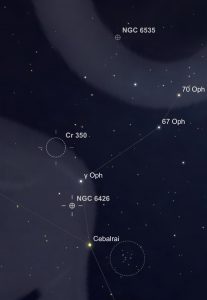
Two diversions in one star chart. After mistakenly hunting down NGC 6535 in Serpens, I needed to head to Gamma Oph, but ran into wonderful Collinder 350. Credit: Sky Safari 5 Pro.
My next target required using Gamma Ophiuchi as a starting point. It should have been a simple sweep east and south from my previously unintended target, but I went slightly too far east and ran into Collinder 350, a beautiful, almost 40 arcminute diameter open cluster. Well worth hunting down if you find yourself in this part of the sky and proved to be a welcome distraction from my ancient prey.
Correcting course, placing Gamma Ophi towards the top of the field meant NGC 6426 was in the bottom quadrant of my 10mm. At magnitude +11.01 this was always going to be difficult. With averted vision, I was able to detect the tiny cluster, but other than a presence, I could not confidently make out any structure.
Using my parallelogram of stars once again, starting with Sabik, I panned up to Nehushtan (Xi Serp), then in a north-west direction for about six degrees to Nu Ophiuchi. Within a 3o line from this star, you will travel across three GCs. NGC 6517, NGC 6539 and Palomar 7 (IC 1276). Only the first is actually Ophiuchun, but I could not resist a quick look at the other two, once again in Serpens. 6539 was actually larger and slightly easier to see at both 24x and 57x. That perceived size difference is actually down to both physical size and approx. 10,000 light year difference in distance. Both clusters show a dense core which seemed to subtend around half the visible diameter, with the remainder being a ghostly symmetrical halo. IC 1276 had similar dimensions as NGC 6517 but a less apparent core.
Checking on my target list, I headed back to where my journey began, Jupiter. Placing the giant planet in the centre of the 24mm meant that both NGC 6287 (to the north) and NGC 6235 (south) were also in the eyepiece, each touching the field stop. Both were initially harder to see than their 5’ dimension and +9.3 and +9.9 magnitudes would suggest due to the glare from Jupiter. Switching to the 10mm, and placing the planet outside the field stop helped substantially with visibility. However, both stubbornly refused to show much detail in any eyepiece I had, taking on the form of small amorphous apparitions.

This field is approx 12×8 degrees and it is rather crowded with globular clusters, meaning plenty of short hops. Credit: Sky Safari 5 Pro.
This part of the sky is packed with GCs and I was able to leap from one to the next without having to use stars to point the way. I initially placed recently visited NGC 6287 on the edge of the 24mm which then placed NGC 6284 near the centre of the field. This cluster is intrinsically far larger appearing both brighter and larger despite being as much as 15,000 light years more distant. The cluster was very symmetrical with a slightly mottled halo which surrounded a stellar like core at 80x. Switching back to the 24mm, and placing both NGC 6827 and 6284 on the bottom edge of the field stop, I then panned just three degrees up to bring NGC 6235 into view. This GC is smaller and closer than either of the previous two clusters, yet subtends a small angular size and lower brightness, reflecting its diminutive size of only 30 light years across. This cluster was probably the hardest I had yet encountered, and required some good concentration and averted vision to tease it into view.
After satisfying myself that I had seen all I would of NGC 6235, I panned back down to NGC 6284 before edging very slightly east to bring M19 into the field. M19 is the most oblate globular known, likely due to tidal interactions with the galactic centre given its rather close proximity of only 5,200 light years. This ellipticity was immediately obvious at 57x. Taking the magnification up to 95x and then 114x with the zoom, I was able to detect hints of a spiral like structure that radiated away from the stellar nucleus across the face of a defuse, hazy halo. The two “spirals” appeared to be rotating in opposite directions.
Switching once again to the 24mm, and placing M19 towards the bottom of the field, brought into view NGC 6293, as well as previously visited, and still elusive, NGC 6284. Centring my latest target and taking the magnification to 81x, revealed a rhombus shaped nucleus which actually seemed to stretch across a good portion of the width of the cluster, with a slightly mottled halo encircling it.
Re-centring NGC 6293 which had drifted towards the field stop while I studied it, I then swept straight up approximately three degrees and landed directly on NGC 6355. This cluster was far smaller, and touch fainter with a tight, stellar core, and what appeared to be slightly fragmented halo, though little if any clear granulation or mottling was seen.
Dropping back down to the star 36 Ophiuchi which I had passed on my way up to NGC 6355, I briefly stopped to enjoy a pair of beautiful, equally bright, golden yellow twin suns separated by about 5”. They are actually part of a triple star system, though the C component is significantly more distant and has little impact on the system. With a 470-year orbital period, these stars are separated on average by 88 AU, but the orbit is highly eccentric varying the separation from a maximum 169 AU to as little as 7 AU.
Having enjoyed the temporary distraction of a pretty double, I panned west NGC 6316, which was best shown in the 10mm. This cluster has a Shapley-Sawyer class concentration of III which means it has a very tight core, and that view seen certainly conveyed a tight nucleus which seemed to responsible for most of the luminosity of this cluster. The halo itself was very faint. Just over one field further west was NGC 6304. This globular was slightly larger, but had about the same overall brightness.
Switching back to 24x magnification, I then panned south three-degrees and landed on M62. Messier’s own notes state this GC resembles a small comet. The irregularity of its shape is very apparent, with the central condensation well offset from the geometric centre, creating the illusion of an icy snowball flying through space, with its short, stubby, dusty tail in pursuit. M19 is one of the closest globular clusters to the galactic centre, and has suffered the consequences of approaching too close to the immense gravity of the central Milky Way.
After enjoying one of the objects that actually gives me some sympathy for Messier and the catalogue he created while actually searching for comets, I panned up to d Ophiuchi, a +4.3-magnitude star using the 24mm eyepiece. This field should have contained Haute Provence 1 (BH 229) and Terzan 2, a +14.3 GC in Scorpius. HP 1 was always going to be challenging at +11.59, and this may well have been my first failure. I might have glimpsed it as a vert faint “star” but cannot say so with any confidence while changing up and down magnifications. Terzan 2 was definitely invisible.
Earlier in the session in my haste to chase down M107, I missed that there were two more of my target list in close proximity to M9, NGC 6356 and NGC 6342. I headed back to Sabik and then panned up to M9 which was now about 47o above the horizon. Though appearing smaller and dimmer than M9, NGC 6356 is in fact a physically more impressive cluster, though more distant. At 81x, the cluster showed a substantial brightening towards the core, reaching a crescendo at the intense stellar nucleus. Panning a short distance east, revealed the other previously missed globular, NGC 6342. This cluster was far smaller, both on an apparent and intrinsic basis. This cluster subtended no more than an arcminute or two and showed a stellar core, and perhaps a slightly asymmetric halo, with elongation along one axis, but it was quite faint and difficult to be sure.
By now it was around 1:05am and I spent just over three hours chasing down and enjoying these archaic relics of the early universe found in Ophiuchus. Reading down my list I only had a few more to find, but a couple of them were going to be tough. Reviewing my star charts, I realised I was heading back to M14 and using that as a springboard to hunt down my next two targets, NGC 6366 and IC 1257. I swept in south-eastly direction from M14 using the 24mm, and hit straight on NGC 6366, which is conveniently sitting on the shoulder of HR 6493, a magnitude +4.5 star. Offsetting NGC 6366 should have also shown IC 1257 in the same field, but it was invisible. NGC 6366 reminded me of a far less impressive Omega Centauri, in that it showed almost uniform brightness across its face, with little to no brightening towards the centre. IC 1257 never did show itself, regardless of eyepiece used, but I should not feel to disappointed, it is magnitude +13.1 and only 1.7 arcminutes across.
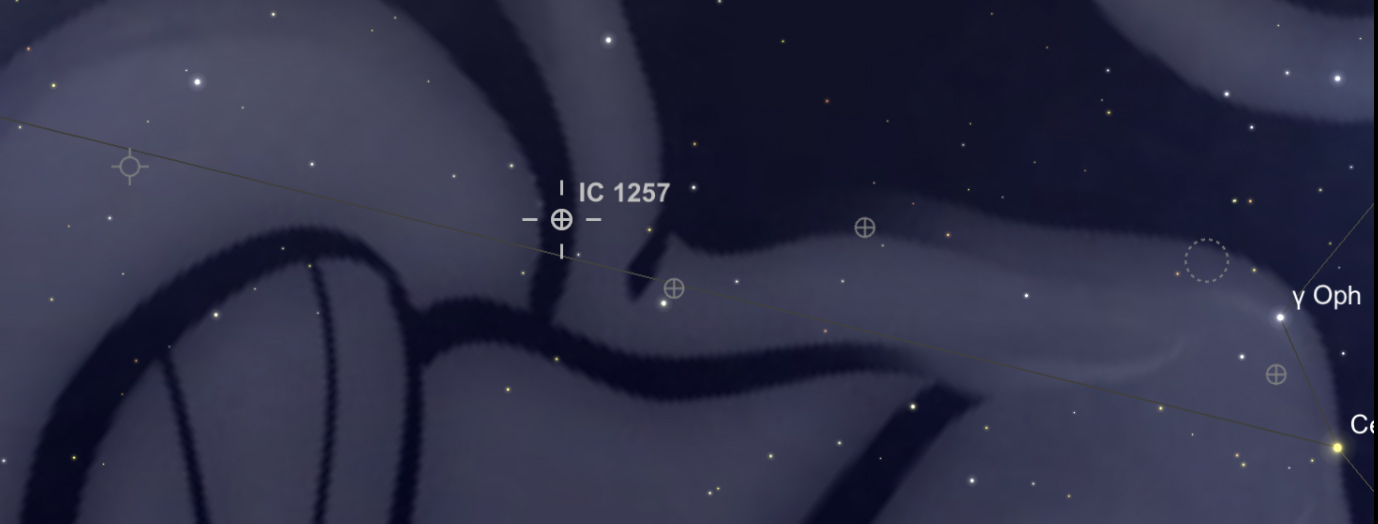
From left to IC 1257, NGC 6366, M14, and on the far right, the earlier distraction of open cluster Collinder 350. Credit: Sky Safari 5 Pro.
Next up was NGC 6401. Using Theta Ophiuchi, which was about ¾ of finder field north of Jupiter, I then swept straight up using the 24mm for four-degrees and hit my target. William Herschel discovered this cluster in 1784 but he incorrectly identified it as a nebula. His son, John made a similar mistake. The cluster appeared slightly triangular to me, but I saw no details that would lead me to conclude any differently from the Herschels, of the type of object I was viewing.
When you target list includes Palomar objects, failure is likely to the outcome. But if you don’t try, you definitely will fail to see it. Panning only about 2-degrees north west brought my gaze to where Palomar 6 lies. Did I see it? Maybe. I don’t feel too bad, Herschel was using a far larger scope and missed it. The cluster was in fact detected in photographic plates from the Palomar Observatory by Robert Harrington and Fritz Zwicky. It is one of four GCs known to contain a planetary nebula.
Palomar 6 is quite a bit brighter than Palomar 15, so chances were non-existent. However, if I locate it, some photons from that distant cluster will hit my retina even if not enough to allow me to perceive it. Palomar 15 forms an isosceles triangle with M10 and M12 with a long axis of about 4o. I moved my scope into position and spent about 10 minutes looking at the field, checking off each field star to ensure I was in the correct location. Alas, nothing, but not surprising.
Last but not least is Pfleiderer 2. This just has “????” in my table for magnitude, so I did not even know what to expect. It seems that until around 2007, this cluster was incorrectly categorised as an open cluster, and Sky Safari 5 Pro still lists it as such. Whatever it is, I would either finish in failure or a blaze of glory. I started this final journey at the head of the serpent collector, Rasalhague (Alpha Ophiuchi) before panning up to Cebalrai (Beta), then a further two degrees to Gamma Ophiuchi. From there my target was just one finder width to the north west. I swept up and placed Zeta Serpentis on the inner quarter of my finder field. Zeta makes an equilateral triangle with the stars HR 6686 and HR 6706. A ¼ of a degree to the side of HR 6706 is the star HD 163976. I centred my finder on this final star as the cluster is only a few arcminutes away. Deep breath first and then I looked into the 10mm. I immediately saw something just offset from the star, which drew my direct gaze and it vanished as quickly as it had been there. Did I see something or was a combination of averted imagination and tiredness playing tricks on me? I spent the next 10 minutes studying the field, but never saw any hint of something again.
At 1:30am I decided to retire for some well-earned rest and packed down my scope, quite pleased that I had run the gauntlet of Ophiuchus globular clusters in three hours and 30 minutes, and despite one or two failures and suspected sightings, had bagged all my targets with only a three-inch scope.







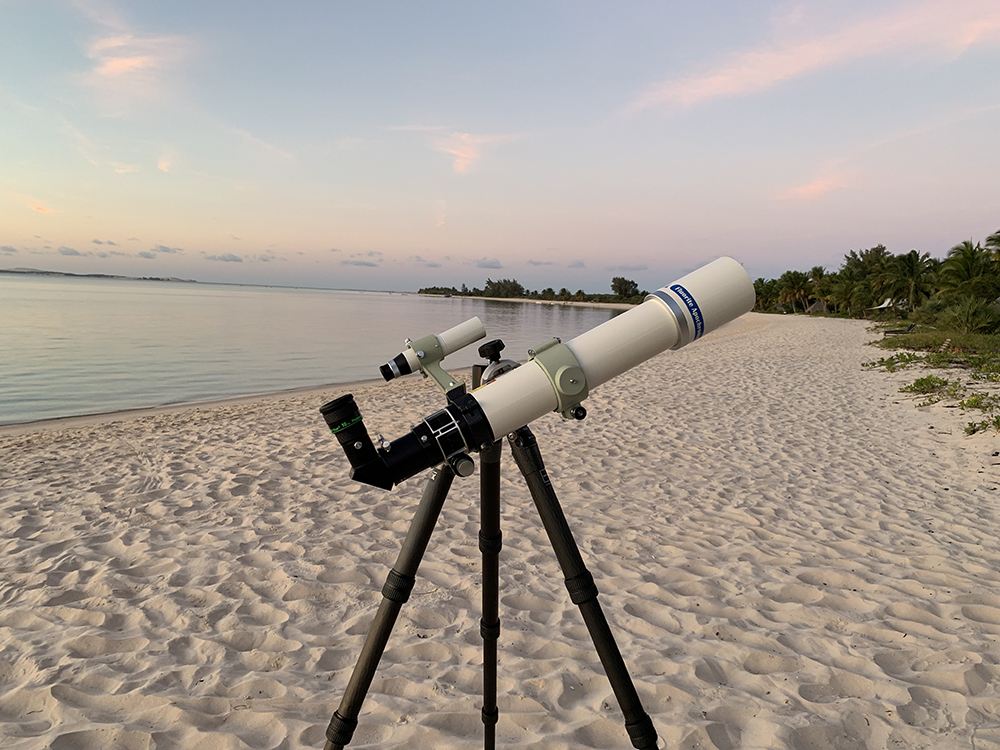
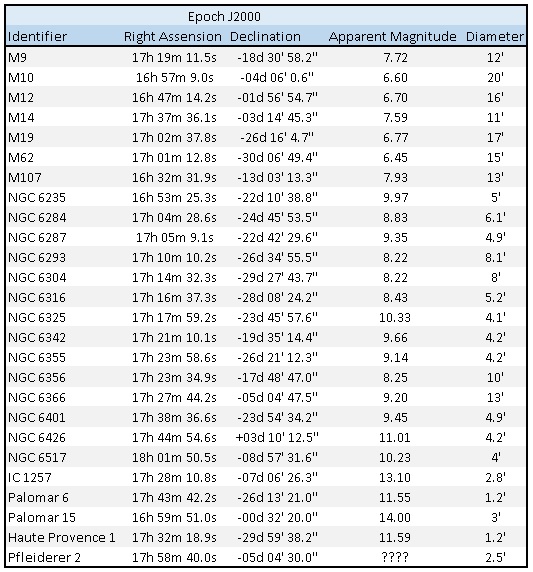
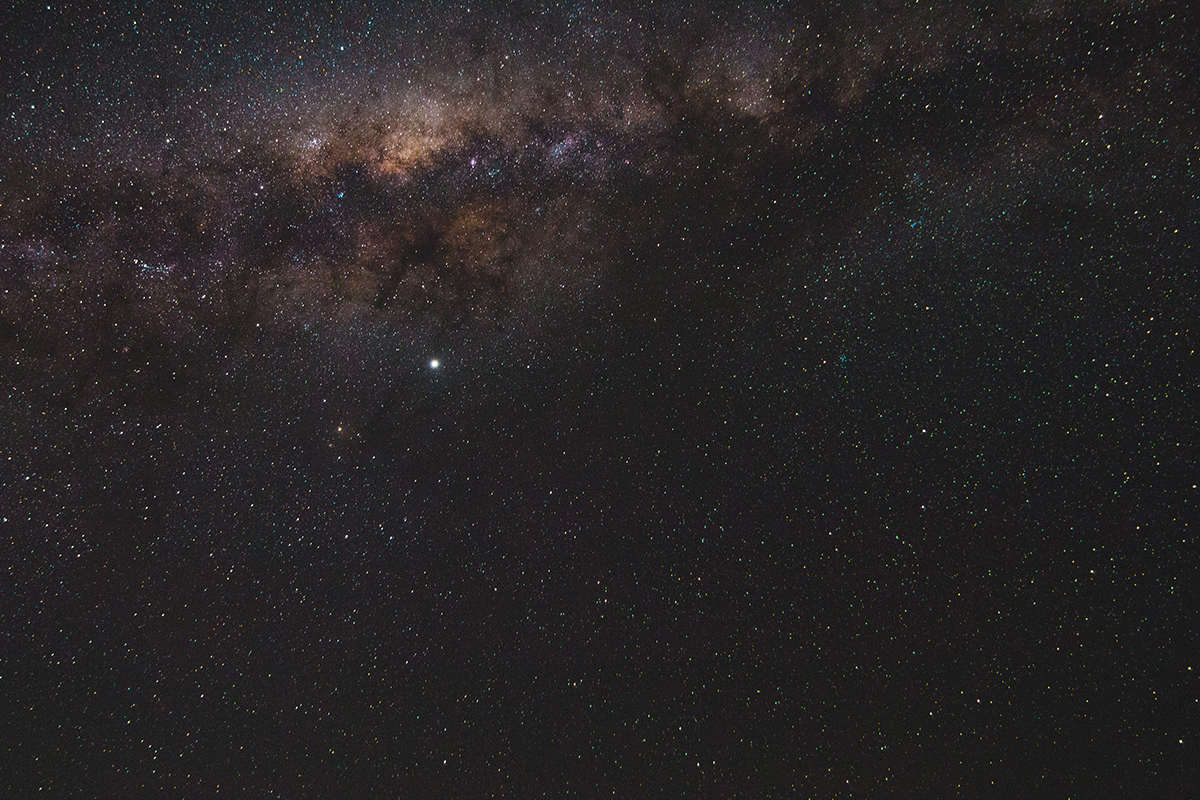
Pingback: Observing all open clusters in Cassiopeia in single session | Alpha Lyrae